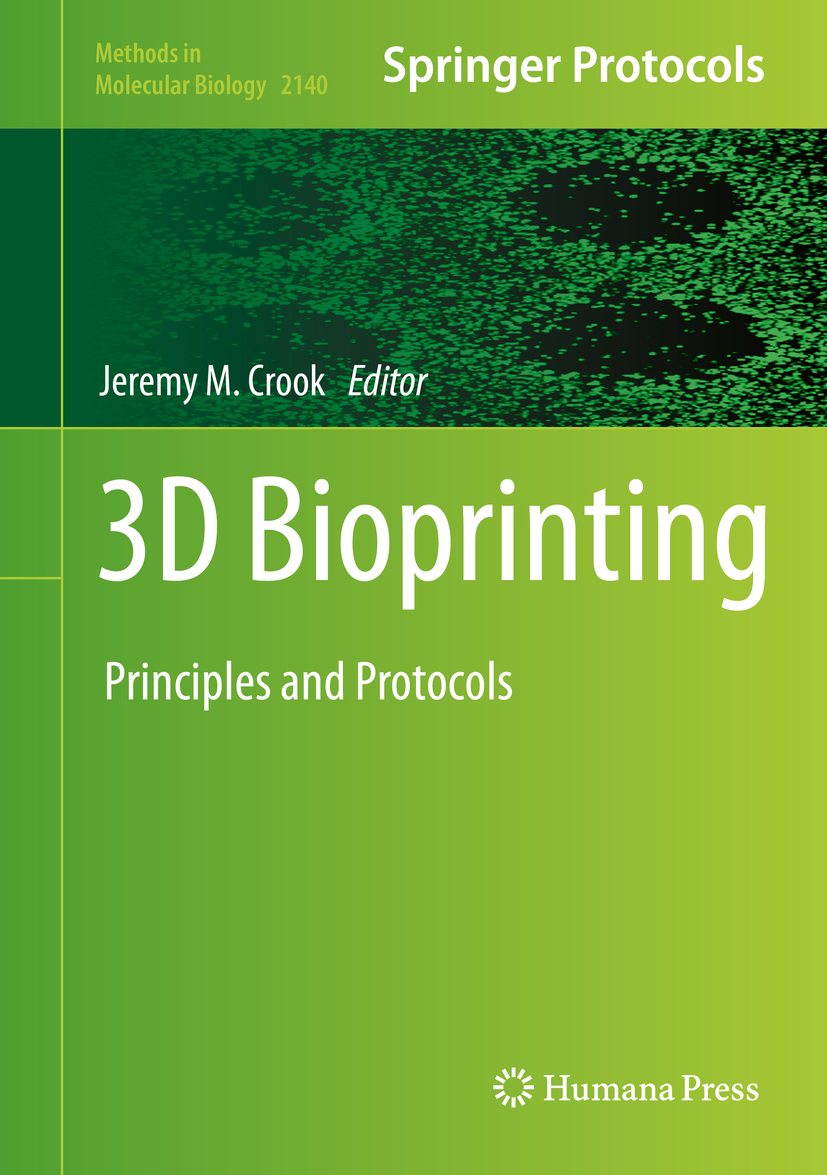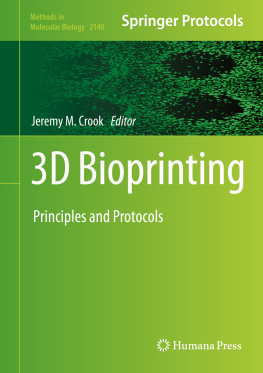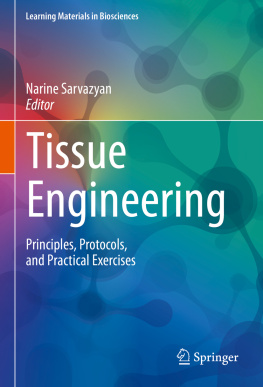Jeremy M. Crook - 3D Bioprinting Principles and Protocols
Here you can read online Jeremy M. Crook - 3D Bioprinting Principles and Protocols full text of the book (entire story) in english for free. Download pdf and epub, get meaning, cover and reviews about this ebook. year: 2020, publisher: Springer US, genre: Home and family. Description of the work, (preface) as well as reviews are available. Best literature library LitArk.com created for fans of good reading and offers a wide selection of genres:
Romance novel
Science fiction
Adventure
Detective
Science
History
Home and family
Prose
Art
Politics
Computer
Non-fiction
Religion
Business
Children
Humor
Choose a favorite category and find really read worthwhile books. Enjoy immersion in the world of imagination, feel the emotions of the characters or learn something new for yourself, make an fascinating discovery.
- Book:3D Bioprinting Principles and Protocols
- Author:
- Publisher:Springer US
- Genre:
- Year:2020
- Rating:5 / 5
- Favourites:Add to favourites
- Your mark:
- 100
- 1
- 2
- 3
- 4
- 5
3D Bioprinting Principles and Protocols: summary, description and annotation
We offer to read an annotation, description, summary or preface (depends on what the author of the book "3D Bioprinting Principles and Protocols" wrote himself). If you haven't found the necessary information about the book — write in the comments, we will try to find it.
3D Bioprinting Principles and Protocols — read online for free the complete book (whole text) full work
Below is the text of the book, divided by pages. System saving the place of the last page read, allows you to conveniently read the book "3D Bioprinting Principles and Protocols" online for free, without having to search again every time where you left off. Put a bookmark, and you can go to the page where you finished reading at any time.
Font size:
Interval:
Bookmark:

For further volumes: http://www.springer.com/series/7651
For over 35 years, biological scientists have come to rely on the research protocols and methodologies in the critically acclaimedMethods in Molecular Biologyseries. The series was the first to introduce the step-by-step protocols approach that has become the standard in all biomedical protocol publishing. Each protocol is provided in readily-reproducible step-by-step fashion, opening with an introductory overview, a list of the materials and reagents needed to complete the experiment, and followed by a detailed procedure that is supported with a helpful notes section offering tips and tricks of the trade as well as troubleshooting advice. These hallmark features were introduced by series editor Dr. John Walker and constitute the key ingredient in each and every volume of theMethods in Molecular Biologyseries. Tested and trusted, comprehensive and reliable, all protocols from the series are indexed in PubMed.

This Humana imprint is published by the registered company Springer Science+Business Media, LLC, part of Springer Nature.
The registered company address is: 1 New York Plaza, New York, NY 10004, U.S.A.
3D bioprinting is a form of additive manufacturing that incorporates a bio-ink comprising cells and/or biocompatible materials for 3D tissue engineering. Using computer-aided design (CAD) for 3D modelling, potentially based on scans taken directly from a patient, bio-inks are printed layer by layer to form scaffolds of desired size and shape, with cells being preserved inside the scaffolds for functional integration, maturation, and tissue formation. Strategies for bioprinting include co-printing of biomaterials with cells for encapsulated cell constructs or printing biomaterial scaffolds that are seeded in vitro or in vivo with cells after printing. Regardless of the approach taken, 3D bioprinting is ideally performed within a regulatory framework of good laboratory practice (GLP) for standardized, optimized, and controlled tissue fabrication, or more rigorous good manufacturing practice (GMP) for clinical-product development. Among other benefits, creating quality tissues is the most immediate way to circumvent the limitations of conventional 2D cell culture and human tissue and organ donation for research and therapeutics.
In recognizing the potential of 3D bioprinting, academic and commercial research and development (R&D) groups around the world are investing significantly in bioprinting infrastructure to prepare for the next major phase in researching and commercializing biomaterials and cell-based products for tissue engineering. Importantly, bioprinting need not entail setting up large and expensive facilities, but can involve smaller initiatives to support the activities of entrepreneurial start-ups, individual universities, research institutes, or laboratories. Whatever the scale or purpose, a printing facility should align with global best practice for working with biomaterials and cells, safeguarding quality fabrication and augmenting research and translational application. For example, the succession of commercial and clinical aspirations could be facilitated by having a low-cost quality-controlled GLP laboratory for research that can support more expensive clinically compliant GMP activities. In addition, research and clinical-grade variants of a printing process will provide consistency between laboratory and clinical activities for more predictable and better translational outcomes.
This volume brings together contributions from experts in 3D bioprinting, and in turn champions, and facilitates the use of bioprinting for quality R&D and translation. The book is divided into two parts with the first covering generic themes in bioprinting to introduce readers new to the field whilst bolstering understanding of those with experience. The second part includes a collection of complete and standardized protocols for preparing, characterizing, and printing a variety of biomaterials/cells/tissues, with priority given to methods for printing defined and humanized constructs suitable for human tissue modelling and clinical practice.
As a volume in the highly successfulMethods in Molecular Biologyseries, it aims to contribute to the development of competence in the subject. By providing information that is necessary to establish 3D bioprinting for research and translation, we hope to encourage the use of this rapidly evolving technology and recommend the volume as a valuable resource for bioprinting laboratories/facilities and those new to the field.
Font size:
Interval:
Bookmark:
Similar books «3D Bioprinting Principles and Protocols»
Look at similar books to 3D Bioprinting Principles and Protocols. We have selected literature similar in name and meaning in the hope of providing readers with more options to find new, interesting, not yet read works.
Discussion, reviews of the book 3D Bioprinting Principles and Protocols and just readers' own opinions. Leave your comments, write what you think about the work, its meaning or the main characters. Specify what exactly you liked and what you didn't like, and why you think so.










